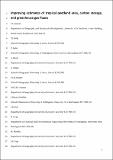Files in this item
Improving estimates of tropical peatland area, carbon storage, and greenhouse gas fluxes
Item metadata
| dc.contributor.author | Lawson, Ian Thomas | |
| dc.contributor.author | Kelly, Thomas | |
| dc.contributor.author | Aplin, Paul | |
| dc.contributor.author | Boom, Arnoud | |
| dc.contributor.author | Dargie, Greta | |
| dc.contributor.author | Draper, Frederick | |
| dc.contributor.author | Hassan, Zamzam | |
| dc.contributor.author | Hoyos-Santillan, Jorge | |
| dc.contributor.author | Kaduk, Jorg | |
| dc.contributor.author | Large, David | |
| dc.contributor.author | Murphy, Wayne | |
| dc.contributor.author | Page, Susan | |
| dc.contributor.author | Roucoux, Katherine Helen | |
| dc.contributor.author | Sjogersten, Sofie | |
| dc.contributor.author | Tansey, Kevin | |
| dc.contributor.author | Waldram, Matthew | |
| dc.contributor.author | Wedeux, Beatrice | |
| dc.contributor.author | Wheeler, James | |
| dc.date.accessioned | 2016-01-05T10:05:55Z | |
| dc.date.available | 2016-01-05T10:05:55Z | |
| dc.date.issued | 2015-06 | |
| dc.identifier | 161185476 | |
| dc.identifier | 99ff9621-f563-4a82-b983-703fb3a7b52b | |
| dc.identifier | 84934982813 | |
| dc.identifier | 000356540000002 | |
| dc.identifier.citation | Lawson , I T , Kelly , T , Aplin , P , Boom , A , Dargie , G , Draper , F , Hassan , Z , Hoyos-Santillan , J , Kaduk , J , Large , D , Murphy , W , Page , S , Roucoux , K H , Sjogersten , S , Tansey , K , Waldram , M , Wedeux , B & Wheeler , J 2015 , ' Improving estimates of tropical peatland area, carbon storage, and greenhouse gas fluxes ' , Wetlands Ecology and Management , vol. 23 , no. 3 , pp. 327-346 . https://doi.org/10.1007/s11273-014-9402-2 | en |
| dc.identifier.issn | 0923-4861 | |
| dc.identifier.other | ORCID: /0000-0001-6757-7267/work/64698087 | |
| dc.identifier.other | ORCID: /0000-0002-3547-2425/work/75996940 | |
| dc.identifier.uri | https://hdl.handle.net/10023/7950 | |
| dc.description | The workshops that led to this article were supported financially by the Universities of Leicester and Nottingham, and the Natural Environment Research Council-funded ‘Earth Observation Technology Cluster’ knowledge exchange initiative | en |
| dc.description.abstract | Our limited knowledge of the size of the carbon pool and exchange fluxes in forested lowland tropical peatlands represents a major gap in our understanding of the global carbon cycle. Peat deposits in several regions (e.g. the Congo Basin, much of Amazonia) are only just beginning to be mapped and characterised. Here we consider the extent to which methodological improvements and improved coordination between researchers could help to fill this gap. We review the literature on measurement of the key parameters required to calculate carbon pools and fluxes, including peatland area, peat bulk density, carbon concentration, above-ground carbon stocks, litter inputs to the peat, gaseous carbon exchange, and waterborne carbon fluxes. We identify areas where further research and better coordination are particularly needed in order to reduce the uncertainties in estimates of tropical peatland carbon pools and fluxes, thereby facilitating better-informed management of these exceptionally carbon-rich ecosystems. | |
| dc.format.extent | 1586003 | |
| dc.language.iso | eng | |
| dc.relation.ispartof | Wetlands Ecology and Management | en |
| dc.subject | Peat | en |
| dc.subject | Greenhouse gases | en |
| dc.subject | Remote sensing | en |
| dc.subject | Tropical ecology | en |
| dc.subject | Carbon cycle | en |
| dc.subject | GE Environmental Sciences | en |
| dc.subject | NDAS | en |
| dc.subject.lcc | GE | en |
| dc.title | Improving estimates of tropical peatland area, carbon storage, and greenhouse gas fluxes | en |
| dc.type | Journal article | en |
| dc.contributor.institution | University of St Andrews. Geography & Sustainable Development | en |
| dc.contributor.institution | University of St Andrews. School of Geography & Sustainable Development | en |
| dc.contributor.institution | University of St Andrews. Bell-Edwards Geographic Data Institute | en |
| dc.identifier.doi | 10.1007/s11273-014-9402-2 | |
| dc.description.status | Peer reviewed | en |
| dc.date.embargoedUntil | 2016-01-03 |
This item appears in the following Collection(s)
Items in the St Andrews Research Repository are protected by copyright, with all rights reserved, unless otherwise indicated.

